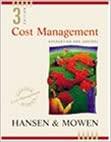Tronico Parts, Inc., produces electronic products with short life cycles (less than two years). Development has to
Question:
Tronico Parts, Inc., produces electronic products with short life cycles (less than two years).
Development has to be rapid, and the profitability of the products is tied strongly to the ability to find designs that will keep production and logistics costs low. Recently manage¬
ment has also decided that postpurchase costs are important in design decisions. Last month a new product was presented to management. The total market was projected at 100,000 units (for the two-year period). The proposed selling price was $30 per unit. The manufac¬
turing and logistics costs were estimated to be $26 per unit. At this price, market share was expected to be 20%.
Upon reviewing the projected figures. Kit Applegate, called in his chief design engi¬
neer, Brian Burnaham, and his marketing manager, Katrina Lochner. The following con¬
versation was recorded:
KIT: Brian, as you know, we agreed that a profit of $5 per unit is needed for this new prod¬
uct. Also, as I look at the projected market share, 20% isn't acceptable. Total profits need to be increased. Katrina, what suggestions do you have?
KATRINA: Simple. Decrease the selling price to $27 and we expand our market share to 35%. To increase total profits, however, we need to lower costs as well.
KIT: You're right. However, keep in mind that I do not want to earn a profit that is less than $5 per unit.
BRIAN: Does that $5 per unit factor in preproduction costs? You know we already have spent $20,000 on developing this product. To lower costs will require more expenditure on development.
KIT: Good point. I do want a design that will provide a $5-per-unit profit, including con¬
sideration of preproduction costs.
KATRINA: I might mention that postpurchase costs are important as well. The current de¬
sign will impose about $1.00 per unit for using, maintaining, and disposing our product.
That's about the same as our competitors. If we can reduce that cost to about $0.50 per unit by designing a better product, we could probably capture about 50% of the market.
Required:
1. Calculate the target cost associated with the initial 20% market share. Does the initial design meet this target?
2. Calculate the target cost for the $27 price and 35% market share. How much more re¬
duction is needed relative to the first design? Describe the three general approaches that Tronico can take to reduce the projected cost to this new target.
3. Compute the total life cycle profit that the current (initial) design offers (including preproduction costs).
4. Suppose that the engineering department has two new designs: Design A and Design B. Both designs reduce production and logistics costs to $21 per unit. Design A, how¬
ever, leaves postpurchase costs at $1 per unit, while Design B reduces postpurchase costs to $0.40 per emit. Developing and testing Design A costs an additional $15,000, while Design B costs an additional $30,000. Calculate the total life cycle profits under each design. Which would you choose? Explain. What if the design you chose cost an additional $50,000? Would this have changed your decision?
5. Refer to Requirement 4. For every extra dollar spent on preproduction activities, how much benefit was generated? What does this say about the importance of knowing the linkages between preproduction activities and later activities?
Step by Step Answer:

Cost Management Accounting And Control
ISBN: 9780324002324
3rd Edition
Authors: Don R. Hansen, Maryanne M. Mowen





